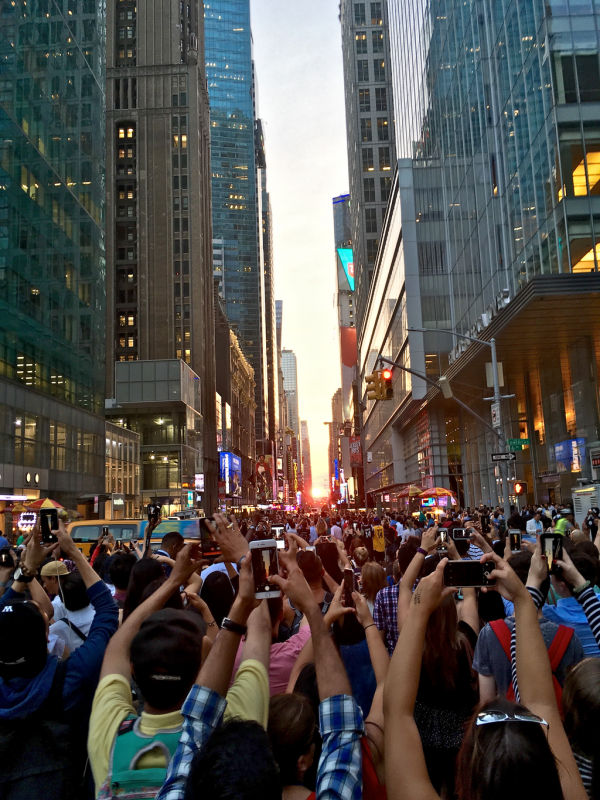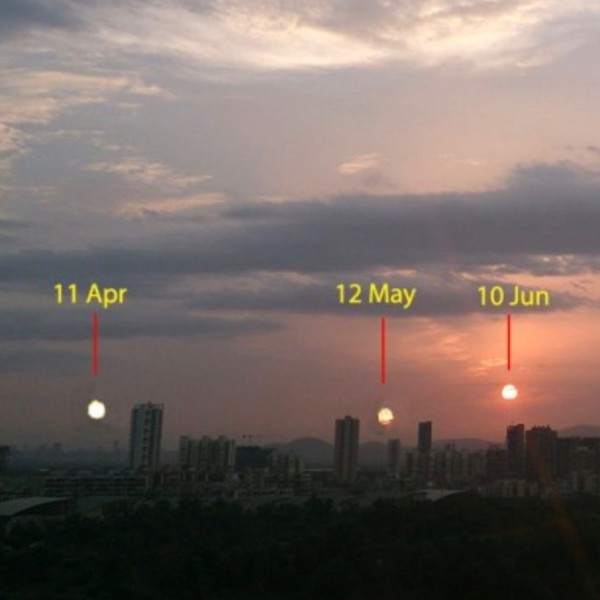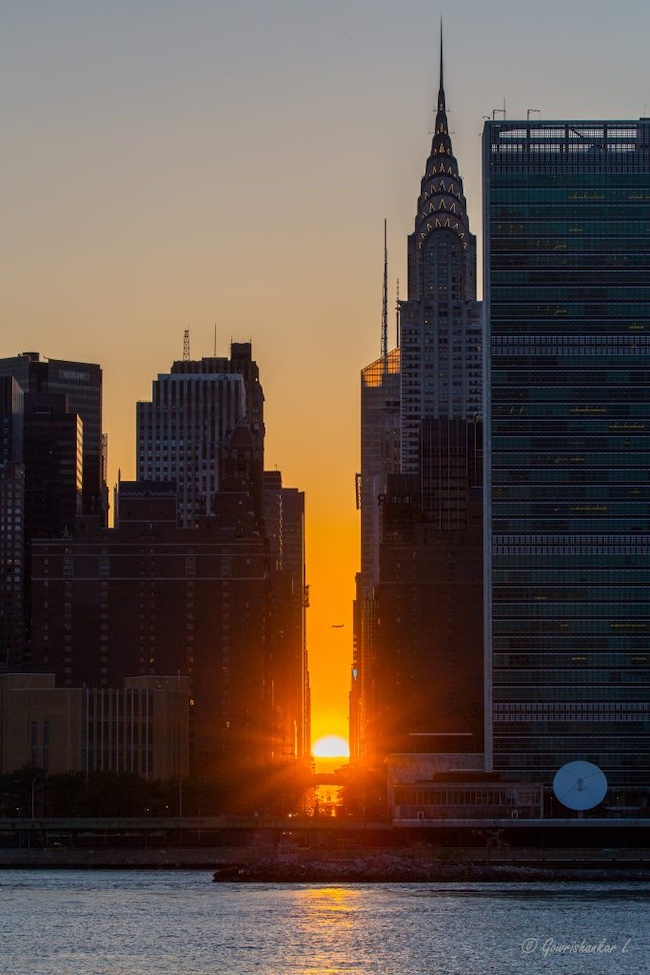
Manhattanhenge, and how to see it
Twice a year – around May 29 and 30, and again around July 11, 12 or 13 – people in New York City look for Manhattanhenge. It’s a phenomenon where the sunset aligns perfectly on east-west oriented streets and avenues of Manhattan. So cool! According to the American Museum of Natural History:
Four nights a year, the streets of Manhattan’s grid become the site for a stunning sunset phenomenon known as Manhattanhenge. During Manhattanhenge, the sun sets in perfect alignment with Manhattan’s east-west numbered streets, creating cinema-worthy photo opportunities.
2023’s Manhattanhenge dates start at the end of May. A half sun will be visible on the grid on Monday, May 29, at 8:13 p.m. EDT, and the full sun will be visible on Tuesday, May 30, at 8:12 p.m. EDT. The second set of dates falls on July 12 (full sun at 8:20 p.m. EDT) and July 13 (half sun at 8:21 p.m. EDT). Between May 29 and July 13, viewers can see the Manhattanhenge Effect, where the sun appears between the grid of the city as it is low in the sky and setting but it doesn’t quite kiss the grid as it sets.
Some of the best places to spot it are along 14th, 23rd, 34th (includes the Empire State Building), 42nd, 57th, and 79th Streets.
Another good place is from the Tudor City Bridge in Manhattan (though it can be crowded) or Hunter’s Point South Park in Long Island City, Queens.
Regardless of where you watch the sunset, make sure you’re as far east as possible while keeping New Jersey in the background across the Hudson River to accentuate the effect.
Tonight’s half Manhattanhenge ?
Tomorrow is full Manhattanhenge ?? pic.twitter.com/jqPup1jSrO— NewYorkCityKopp (@KellyrKopp) May 30, 2023
More good locations and tips from the NYC Parks Department.
Neil deGrasse Tyson on Manhattanhenge
The name Manhattanhenge was coined by astrophysicist Neil deGrasse Tyson. It’s a nod to the prehistoric monument Stonehenge in England, which was designed to frame the summer solstice sunrise and the winter solstice sunset. Manhattanhenge is accidental. It happens because Manhattan was built with a grid system of streets, running north-south and east-west. Tyson explains in the video, above.
Aligned sunsets
Each Manhattanhenge is actually two days. On the first day the sun’s full disk aligns with the street grid, and the next day half the sun’s disk aligns with the street grid.
The two sets of aligned sunsets are centered on the summer solstice, leading to the effect’s other, incorrect name, the Manhattan Solstice. The first set of Manhattanhenge dates are on May 29 and 30.
As the sun appears to move south again after the solstice on June 21, the effect repeats in reverse. The full solar disk appears at the horizon on July 12. Then, the half disk alignment occurs the following day on July 13. Depending on the year, these dates can shift by a day.
Six months later, Reverse Manhattanhenge happens around the mornings of January 11-12, when the rising sun creates the same effect on the other side of the island at shortly after 7 a.m. EST.
Solstice and equinox alignments around the world
The phenomenon of Manhattanhenge is fun. And it’s one of many similar alignments that occur around the world on various dates. Think Stonehenge at the equinoxes and solstices.
The point of sunset along the horizon varies throughout the year. At this time of year – between the June solstice and the September equinox – the sunset point is shifting southward each day on the horizon as seen from around the globe. It’s the southward-shifting path of the sun that gives us winter in the Northern Hemisphere and summer in the Southern Hemisphere. And it’s the shifting path of the sun that gives people various alignments of the sunset with familiar landmarks.

Watching Manhattanhenge
You can observe Manhattanhenge from lots of different places on the east-west streets of the Manhattan street grid. The best places to watch Manhattanhenge are wide streets with an unobstructed view toward New Jersey across the Hudson River.
Popular spots are 34th Street near the Empire State Building and 42nd Street near the Chrysler Building. Wide cross streets – such as 14th, 34th, 42nd and 57th Streets – that ensure the best views of the west-northwest horizon (toward New Jersey) are generally good spots.
Keep in mind that Manhattanhenge draws large crowds, especially around the city’s landmarks.
Why does Manhattanhenge happen?
The June solstice on June 21 brings the sun’s northernmost point in our sky and northernmost sunset. Afterward, the sun’s path in our sky, and the sunset point, will both start shifting southward again. As for the sun’s alignment with the city of New York, and the streets of Manhattan Island … well, thank the original planners of this city. Scientific American explained:
The phenomenon is based on a design for Manhattan outlined in The Commissioners’ Plan of 1811 for a rectilinear grid or gridiron of straight streets and avenues that intersect one another at right angles. This design runs from north of Houston Street in Lower Manhattan to just south of 155th Street in Upper Manhattan. Most cross streets in between were arranged in a regular right-angled grid that was tilted 29 degrees east of true north to roughly replicate the angle of the island of Manhattan.
And because of this 29-degree tilt in the grid, the magic moment of the setting sun aligning with Manhattan’s cross streets does not coincide with the June solstice but rather with specific dates in late May and early July.
EarthSky Community Photos of Manhattanhenge

Did you get a photo of Manhattanhenge? We’d love to see it! Submit it to us at EarthSky Community Photos.
Bottom line: Each year around May 29 and 30, and again around July 12 and 13, New Yorkers watch for Manhattanhenge.
Read more about Manhattanhenge from ScientificAmerican.com
Read more about Manhattanhenge from American Museum of Natural History
The post Manhattanhenge in 2023: When and where to see it first appeared on EarthSky.
from EarthSky https://ift.tt/zv4f2GR

Manhattanhenge, and how to see it
Twice a year – around May 29 and 30, and again around July 11, 12 or 13 – people in New York City look for Manhattanhenge. It’s a phenomenon where the sunset aligns perfectly on east-west oriented streets and avenues of Manhattan. So cool! According to the American Museum of Natural History:
Four nights a year, the streets of Manhattan’s grid become the site for a stunning sunset phenomenon known as Manhattanhenge. During Manhattanhenge, the sun sets in perfect alignment with Manhattan’s east-west numbered streets, creating cinema-worthy photo opportunities.
2023’s Manhattanhenge dates start at the end of May. A half sun will be visible on the grid on Monday, May 29, at 8:13 p.m. EDT, and the full sun will be visible on Tuesday, May 30, at 8:12 p.m. EDT. The second set of dates falls on July 12 (full sun at 8:20 p.m. EDT) and July 13 (half sun at 8:21 p.m. EDT). Between May 29 and July 13, viewers can see the Manhattanhenge Effect, where the sun appears between the grid of the city as it is low in the sky and setting but it doesn’t quite kiss the grid as it sets.
Some of the best places to spot it are along 14th, 23rd, 34th (includes the Empire State Building), 42nd, 57th, and 79th Streets.
Another good place is from the Tudor City Bridge in Manhattan (though it can be crowded) or Hunter’s Point South Park in Long Island City, Queens.
Regardless of where you watch the sunset, make sure you’re as far east as possible while keeping New Jersey in the background across the Hudson River to accentuate the effect.
Tonight’s half Manhattanhenge ?
Tomorrow is full Manhattanhenge ?? pic.twitter.com/jqPup1jSrO— NewYorkCityKopp (@KellyrKopp) May 30, 2023
More good locations and tips from the NYC Parks Department.
Neil deGrasse Tyson on Manhattanhenge
The name Manhattanhenge was coined by astrophysicist Neil deGrasse Tyson. It’s a nod to the prehistoric monument Stonehenge in England, which was designed to frame the summer solstice sunrise and the winter solstice sunset. Manhattanhenge is accidental. It happens because Manhattan was built with a grid system of streets, running north-south and east-west. Tyson explains in the video, above.
Aligned sunsets
Each Manhattanhenge is actually two days. On the first day the sun’s full disk aligns with the street grid, and the next day half the sun’s disk aligns with the street grid.
The two sets of aligned sunsets are centered on the summer solstice, leading to the effect’s other, incorrect name, the Manhattan Solstice. The first set of Manhattanhenge dates are on May 29 and 30.
As the sun appears to move south again after the solstice on June 21, the effect repeats in reverse. The full solar disk appears at the horizon on July 12. Then, the half disk alignment occurs the following day on July 13. Depending on the year, these dates can shift by a day.
Six months later, Reverse Manhattanhenge happens around the mornings of January 11-12, when the rising sun creates the same effect on the other side of the island at shortly after 7 a.m. EST.
Solstice and equinox alignments around the world
The phenomenon of Manhattanhenge is fun. And it’s one of many similar alignments that occur around the world on various dates. Think Stonehenge at the equinoxes and solstices.
The point of sunset along the horizon varies throughout the year. At this time of year – between the June solstice and the September equinox – the sunset point is shifting southward each day on the horizon as seen from around the globe. It’s the southward-shifting path of the sun that gives us winter in the Northern Hemisphere and summer in the Southern Hemisphere. And it’s the shifting path of the sun that gives people various alignments of the sunset with familiar landmarks.

Watching Manhattanhenge
You can observe Manhattanhenge from lots of different places on the east-west streets of the Manhattan street grid. The best places to watch Manhattanhenge are wide streets with an unobstructed view toward New Jersey across the Hudson River.
Popular spots are 34th Street near the Empire State Building and 42nd Street near the Chrysler Building. Wide cross streets – such as 14th, 34th, 42nd and 57th Streets – that ensure the best views of the west-northwest horizon (toward New Jersey) are generally good spots.
Keep in mind that Manhattanhenge draws large crowds, especially around the city’s landmarks.
Why does Manhattanhenge happen?
The June solstice on June 21 brings the sun’s northernmost point in our sky and northernmost sunset. Afterward, the sun’s path in our sky, and the sunset point, will both start shifting southward again. As for the sun’s alignment with the city of New York, and the streets of Manhattan Island … well, thank the original planners of this city. Scientific American explained:
The phenomenon is based on a design for Manhattan outlined in The Commissioners’ Plan of 1811 for a rectilinear grid or gridiron of straight streets and avenues that intersect one another at right angles. This design runs from north of Houston Street in Lower Manhattan to just south of 155th Street in Upper Manhattan. Most cross streets in between were arranged in a regular right-angled grid that was tilted 29 degrees east of true north to roughly replicate the angle of the island of Manhattan.
And because of this 29-degree tilt in the grid, the magic moment of the setting sun aligning with Manhattan’s cross streets does not coincide with the June solstice but rather with specific dates in late May and early July.
EarthSky Community Photos of Manhattanhenge

Did you get a photo of Manhattanhenge? We’d love to see it! Submit it to us at EarthSky Community Photos.
Bottom line: Each year around May 29 and 30, and again around July 12 and 13, New Yorkers watch for Manhattanhenge.
Read more about Manhattanhenge from ScientificAmerican.com
Read more about Manhattanhenge from American Museum of Natural History
The post Manhattanhenge in 2023: When and where to see it first appeared on EarthSky.
from EarthSky https://ift.tt/zv4f2GR

Aucun commentaire:
Enregistrer un commentaire